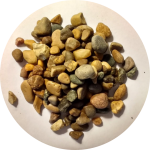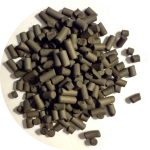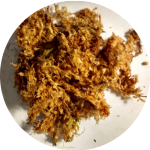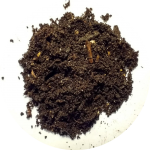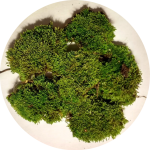Is today another grey day? The equinox is around the corner, but balmy weather, budding flowers, and seas of green grass could be a long ways away. If you missed out on our Diorama’orama event, you didn’t get a chance to make a free sealed terrarium. Never fear, here are some instructions for you to make your own, portable, day-brightening, emerald oasis.
What you’ll need:
- 1 jar with a lid (mason jars are great for this!)
- A handful of stones and pebbles
- Activated Carbon
- Peat moss (optional)
- Potting soil
- Greenery
- A stick, dowel, or tweezers for arranging plants.
First: make sure your jar is clean – you want to be able to see your wonderful creation when you’re done! We’ll start by putting in a layer of stones. We ultimately want about half the container to be filled with air, so you don’t need too many – just enough to create a little reservoir for excess water.
Now layer in your activated carbon. Activated carbon acts as a filter, making sure your terrarium stays clean – it’s often used in filters for fish tanks and can be found in the fish section of pet stores. You don’t need too much – only enough to cover your stones!
I had some extra peat moss laying around that I chose to layer in over the activated carbon. Peat moss is nothing short of a wonder. Formed over thousands of years, peat moss is the result of mosses and other plants dying and slowly decomposing in the oxygen-free muck found in swamps and bogs. Peat moss holds onto nutrients remarkably well and adds a bit of acidity to the mix.
The soil is then placed over your peat moss or activated carbon. Depending on the size of your jar you can add an inch or so soil. This serves as a base for the most exciting part of our terrariums: the plants!
I found all of my plants – and almost all of the other materials I used – in a parking lot by my house. If you look closely, cracks in the asphalt are practically a jungle of grasses, mosses, and weeds. The key is to find scrappy plants that can survive a transplant, but you also need slow growing plants that won’t grow out of their new home too quickly. Moss is the happy medium and can be found almost anywhere. Try looking in shady park paths, parking lots, and in patches of grass.
A visually appealing terrarium depends a lot on plant variation and elevations. A flat, uniform patch of moss isn’t too interesting. By having one side of terrarium higher than the other, and by incorporating a few types of slow growing plants, an interesting landscape is sculpted. A tool for placing plants is essential here. I used a pencil to dig holes for transplanting and for packing in soil around my plants.
Finally, drip some water over your plants, put on the lid, and voila: you’ve made a sealed terrarium! If you want to create more fun art projects and build our community’s creative capacity at the same time, check out our volunteer tab to see how you can help!







